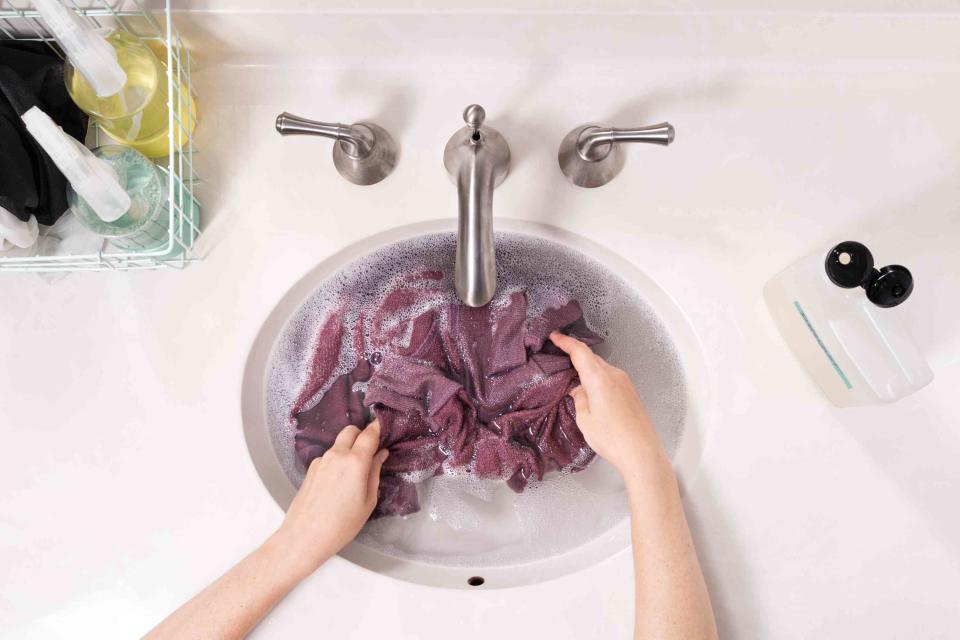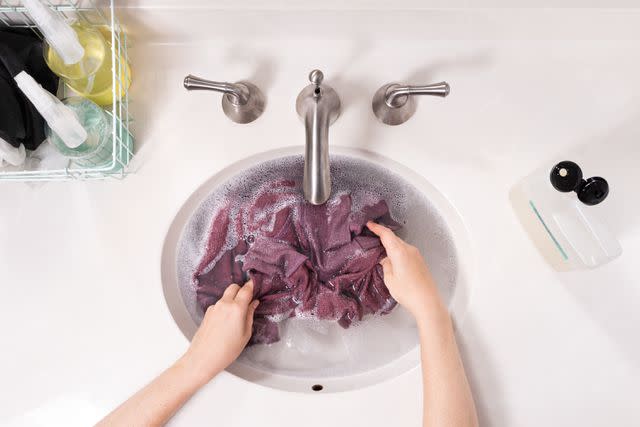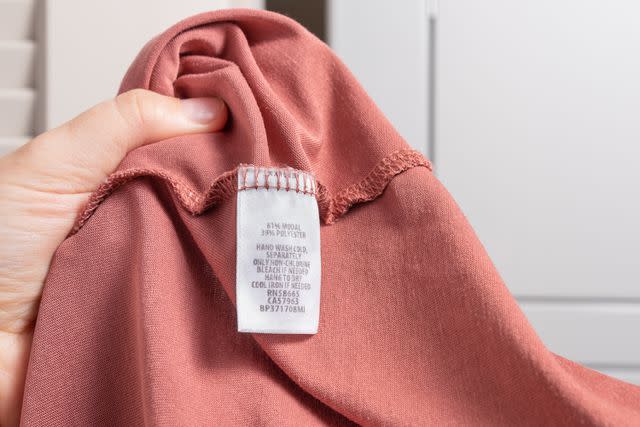How to Hand-Wash Clothes to Preserve Your Delicate Pieces

Extend the life of the special items in your closet with these tips on how to properly wash items like sweaters, lingerie, and other delicate clothing by hand.

BHG / Laura Wheatley
When laundry day comes around, most washing machines offer a delicate or hand-wash setting, but there are times when washing clothes by hand will truly produce the best results. If you're not sure how to hand-wash clothes, we've got you covered.
Some unique fabrics require special care. Items such as delicate lingerie, wool sweaters, and silk blouses often retain their color and shape best when washed by hand. However, what products should you use and how long should you soak an item?
Below, we've rounded up step-by-step directions for the best way to hand-wash clothes below, as well as advice on how to dry items to extend their life and keep them looking as good as the day you bought them.

BHG / Laura Wheatley
How to Hand-Wash Clothes
Not every clothing item can be thrown into your washing machine. For delicate items or clothing labels with a hand wash symbol, follow these simple step-by-step instructions for washing clothes by hand.
Step 1: Read the label.

BHG / Laura Wheatley
Always check the care label for directions. If your garment features the hand wash symbol, which portrays a hand in a tub of water, follow our instructions below for cleaning clothes by hand. If the label says "dry-clean only," avoid washing it at home. If the label simply says "dry-clean," you might want to try hand-washing the item. Before you hand-wash the garment, check a small inconspicuous area first to make sure the fabric is colorfast.
Step 2: Fill a tub with water.
Fill a small tub or sink with water at the temperature recommended on the care label. If no care label exists, choose cool to lukewarm water. Add about a teaspoon of detergent. You might need more detergent if you are hand-washing a large item or multiple items.
Step 3: Submerge and soak the item.
Submerge the garment in soapy water and soak. Use gentle movements to swish the item through the sudsy water. Avoid scrubbing or twisting actions that can stretch or damage the fabric. Gently swish the garment through the sudsy water until the item is clean. You can also purchase hand-washing clothes tools, but unless you're hand-washing clothes regularly, these are not necessary.
Step 4: Rinse and repeat.
Drain the sink or tub, and refill it with cool rinse water. Push the garment up and down in the water until all soap is removed. If you're unsure, sniff the garment to make sure it is no longer scented. Repeat the process with clean water if necessary.
Related: The Best Way to Wash Down-Filled Items, Including Comforters and Pillows
How to Hand-Wash Bras and Lingerie
To preserve the shape and delicate details of bras and lingerie, hand-washing is recommended. Follow our instructions for washing bras by hand.
Tip
Silk garments should not be hand-washed if they are brightly colored, patterned, or darkly colored, as the dyes could bleed. Baby clothes might also have special hand-washing requirements, so check the label to be sure.
Step 1: Soak the bra.
Fill a sink or bowl with lukewarm water. Add a mild, alcohol-free hand-washing detergent ($5, Walmart) and mix in with the water. Carefully place the bra in the solution and let soak for 15 minutes. With your hands, work the suds into the bra.
Step 2: Rinse away soap.
Remove the bra from the water. Hold under the sink or tub faucet and let water run over the bra, rinsing out any soapy water. Be sure to rinse until the bra no longer releases any suds.
Step 3: Dry the bra.
To get rid of any excess water, gently fold your bra against a towel before laying it out to dry. Lay the garment flat on a towel and lay another towel over top and press to remove extra water. Always hang bras to dry.
How to Hand-Wash Tights
Delicate hosiery and tights require careful laundering to prevent snags and tears. Here's how to wash tights by hand.
Step 1: Prep hand-washing detergent.
Fill a sink with lukewarm water and add half a cup of mild laundry detergent to wash your tights. Any detergent will do, but you can also look for detergent specially made for delicate clothes. Make sure you use lukewarm water, as hot water can actually reduce the elasticity of your tights and affect their fit.
Step 2: Submerge the tights.
First, turn your tights inside-out. Gently place the tights in the water mixture and begin to scrub. Avoid any rubbing and pulling, and just gently scrub the areas that are most prone to bacteria like the feet and crotch area. Let your tights soak for about 10 minutes or so.
Step 3: Rinse and dry.
Once done soaking, remove the tights from the water. Rinse them under a sink faucet with cold water. Rinse until no more suds leave the tights. Tighten into a ball and squeeze out excess water. Place tights on top of a towel and roll up to dry any remaining spots. Lay flat to dry on a lint-free towel.

How to Hand-Wash a Sweater
Check the label of your sweater before washing. Many sweater materials, including cashmere and wool, require hand-washing. Here's how to successfully remove stains and odors from sweaters.
Step 1: Prep hand-washing detergent.
Fill a tub or sink with tepid water and a few drops of mild detergent, such as dishwashing liquid. To neutralize perspiration odor, add 3/4 cup of white vinegar.
Step 2: Soak and rinse the sweater.
Turn the sweater inside-out. Immerse the sweater in the water, and swish gently, taking care not to stretch it. Let soak for 10 minutes. Next, run cold water over the sweater until no more soapy residue runs from the garment.
Step 3: Dry the sweater.
Once done soaking, press the sweater against the wall of the bin to remove any excess water. Lay the sweater on a white towel on a flat surface (a white towel prevents dye transfer from the towel to the sweater). Gently roll the towel and sweater together to remove extra water.
Dry the sweater on a flat, moisture-resistant surface, preferably mesh, which lets air circulate. Keep it away from sun and heat. As it dries, coax the sweater back into its shape, squaring the shoulders, placing the sleeves parallel to the body, and squaring the hem.
Related: Wash Away Germs from Clothing and Fabrics with These Laundry Sanitizing Tips
How to Hand Wash a Hat
Baseball caps are helpful for protecting your eyes from the sun, but they can quickly become dirty with perspiration and body oils. Learn how to hand-wash a hat with our easy tutorial.
Step 1: Pre-treat stains.
First, determine whether your baseball cap has a cardboard bill. To do so, simply tap the bill; if it has a hollow sound, it's likely cardboard and you should avoid submerging in water. Instead, simply spot-treat vintage hats and baseball caps with cardboard bills.
If your hat shows stains or discoloration, especially around the sweatband, treat them with a gel stain remover ($5, Target) before washing. Let the solution soak in according to the manufacturer's instructions before washing.
Step 2: Fill a sink and wash the hat.
Fill a sink or container with enough cool water to fully submerge the hat. Add a few drops of liquid laundry detergent and agitate water until bubbles form. Soak hat for about 10-15 minutes.
Step 3: Rinse and dry the hat.
Rinse the hat with cool water and gently squeeze to remove suds, avoiding the bill. Pat dry with a clean towel, then air-dry over a small bowl or container to maintain the shape.

How to Dry Hand-Washed Clothing
Once you've washed your clothes by hand, you'll likely need to line-dry your clothing. Use these tips for success.
Step 1: Squeeze out excess water.
Gently squeeze the excess water from the garment. Do not twist or wring the item as it could stretch the fibers and ruin the fabric.
Step 2: Lay the item on a towel.
On a flat surface, lay out a clean, dry white bath towel that has been laundered several times to remove lint. Lay the just-washed garment on the towel, patting it into shape. Roll up the towel, encasing the garment in the towel. Gently press on the rolled-up towel to encourage water absorption. Repeat with another clean, dry towel if the first one becomes saturated.
Step 3: Let hand-washed clothes air dry.
Follow the garment's label directions for reshaping and drying. If no care label exists, lay the hand-washed clothes on a clean, dry white towel spread over a flat surface that is moisture-resistant. Flip the garment over periodically, and replace the damp towel with a dry one as needed. You can also air dry on a flat, moisture-resistant surface, preferably mesh, which lets air circulate around the clothes.
Air-dry delicate lingerie on a drying rack. If the dry garment is wrinkled, check the care label for appropriate ironing temperature, and if necessary, press the garment gently to finish. If no care label exists, test in an inconspicuous area before pressing. Hang or fold clothing as soon as it's dry to avoid wrinkles.
Frequently Asked Questions
When should you avoid hand-washing clothes?
If an item’s manufacturer label says, “dry clean only,” your best bet is to adhere to the suggestion. Also, while hand-washing will do in a pinch, heavy-duty items like towels should be machine-washed.
Does hand-washing clothes sanitize them?
No. When a washing machine sanitizes clothes, it does so with high-temperature water (often 140°F or hotter). Water that hot would be too hot for hand-washing. So, to sanitize hand-washed clothing, try steaming or ironing your pieces when they are dry.
For more Better Homes & Gardens news, make sure to sign up for our newsletter!
Read the original article on Better Homes & Gardens.

